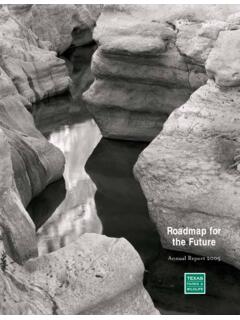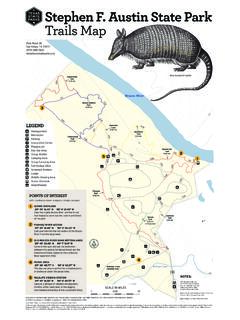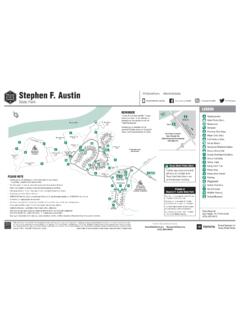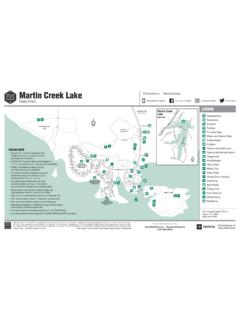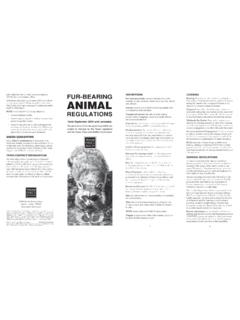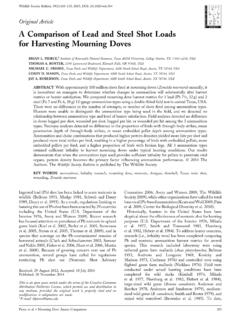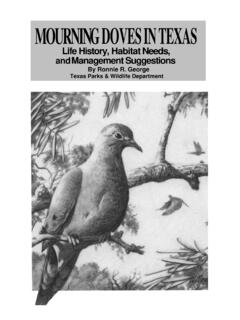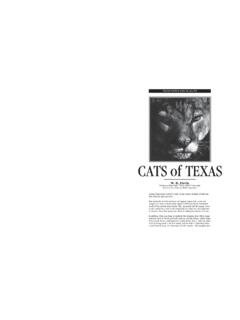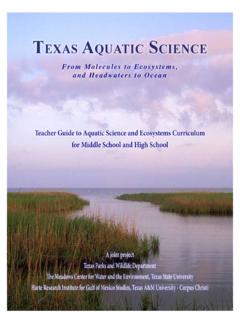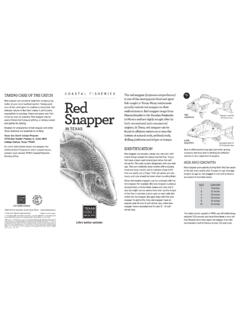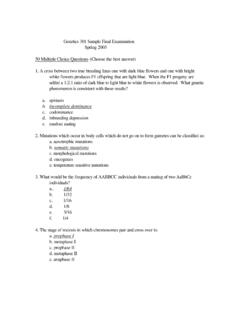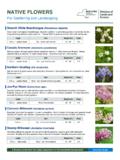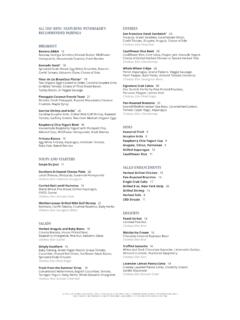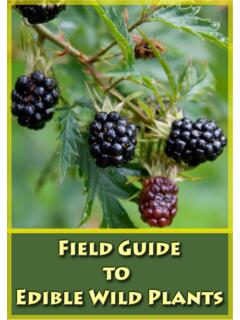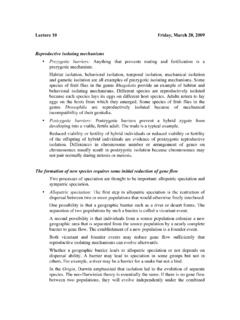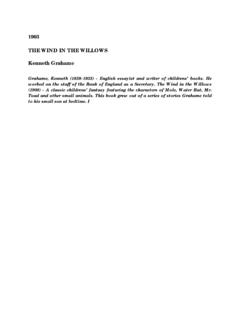Transcription of Common Woody Browse Plants Utilized by White-Tailed Deer ...
1 White-Tailed deer eat the leaves, stems, seeds and fruit of a wide variety of plant species. They choose vegetation based on palatability, seasonal availability, vegetative abundance, precipitation and overall quality of the habitat. Deer diets may consist primarily of forbs when abundant, but forbs are dependent on adequate rainfall and are not always available. In semi-arid South Texas, rainfall is extremely variable, and Woody Plants are the most stable and consistent portion of the deer s diet. When deer Browse , they tend to select the youngest and most tender growth first, which is usually the new leaves and stem tips. By observing which Browse Plants deer are eating on your property, it is possible to get a better feel for the health of the deer herd and their habitat.
2 This brochure is intended to help landowners identify the most Common Browse species preferred by White-Tailed deer. The following Plants are grouped by preference of the leaves and twigs, but many less preferred Plants are also important seasonally in the diet. Many less preferred species are also important for thermal regulation and screening cover. It is much more important to manage for a diversity of species than simply for the first choice Plants listed here. For additional information, see A Field Guide to Common South Texas Shrubs, by Taylor, Rutledge and Herrera, Texas Parks and Wildlife Press, 1997. All Plants listed here are found primarily in the South Texas Plains, which encompasses much of South Texas, unless otherwise reported, the crude protein content of these Browse Plants is listed after the Common name.
3 Crude protein content varies with seasonal and habitat conditions; all values reported here are spring values, which are generally the highest of the year. Crude protein data and plant descriptions were obtained from A Field Guide to Common South Texas Shrubs, by Taylor, Rutledge and Herrera, Texas Parks & Wildlife Press, 1997; Trees, Shrubs & Cacti of South Texas, by James H. Everitt, D. Lynn Drawe, and Robert Lonard, Texas Tech University Press, 2002; and USDA Plant Database Website at Woody Browse Plants Utilized by White-Tailed Deer in South Texasby Daniel J. Kunz, Eric P. Garza and Michael W. WallaceSouth Texas PlainsSouthern Edwards Plateau (SEP)Rio Grande Valley (RGV)Coastal Sand Plains (CSP)Gulf Coast Prairies and Marshes (GCP)Cedar Elm (Olmo)Ulmus crassifoliaTree; leaves with serrated edges and prominent veins be-low; brown slender twigs, bark sometimes with flattened ridges; winged seeds; found mainly near Saltbush (Chamiso) 12%Atriplex canescensShrub; with numerous, alternate leaves, thornless; small spikelets of yellow flowers during summer and four-winged shaped fruit August-October; Prefers saline soils in the western portion of South (Spiny Hackberry) 15-28%Celtis pallidaShrub.
4 Evergreen with zig-zagged, smooth, gray branches and stout, paired spines; alternate leaves and orange berries resembling a tiny (Ironwood) 14-26%Guaiacum angustifoliumShrub; evergreen with short, stout, thornless, knotty branches; thick, dark green leaves crowded on nodes; purple flowers ; red seeds enclosed in a brown (Barbados Cherry) - RGVM alpighia glabraShrub; usually found in the understory, thornless; small pink flowers appear periodically and are followed by bright red fruit. Frequently planted as an Pear (Nopal) 2-13%Opuntia engelmanniiCactus; erect or spreading and thick-padded; may have a cylindrical trunk; flowers may be yellow, orange or red from April to June; red to dark purple fruit called tunas ripen July-September; Although low in protein, this plant is high in energy, digestibility and water content and is a staple during dry Bernardia (Oreja de Raton) 15-20%Bernardia myricifoliaShrub; thornless and densely branched; alternate leaves dark green on top and light green to gray and densely hairy on the underside with wavy margins.
5 Fruit rounded and three-seeded with three lobed capsule occurring at stem Hackberry (Palo Blanco) 19-28%Celtis laevigataTree; bark is gray with conspicuous warty bumps; leaves pale green and asymmetrical at base; late-summer orange to brown/red or black berry; found mainly near Kidneywood (Vara Dulce) 17-26%Eysenhardtia texanaShrub; stems multiple, thornless, slender, gray, and irregularly shaped; leaves are compound and alternate with small leaflets that emit a strong odor when crushed; small white flowers form elongated clusters at stem tips which become small dotted choice Browse Plants most Utilized by deer whenever present, also called ice cream Ephedra (Popotillo) 12-18%Ephedra antisyphiliticaShrub; small, usually 1 to 4 feet tall, low-spreading, with leafless-appearing stiff, green, multi-noded stems; leaves tiny, scale like, and cone like; fruit smooth, succulent, and red, occurring at the 13-20%Sideroxylon celastrinumShrub or small tree; semi-evergreen; spiny with clustered, dark green teardrop-shaped leaves and oblong black berries Berry - GCP Callicarpa americanaShrub; may grow to 9 feet.
6 Leaves large, simple, with toothed margins, leaves and stems covered with dense minute pubescence, thornless; fruit red, lavender or bluish berries occurring at the (Texas or Purple Sage) 12-16%Leucophyllum frutescensShrub; rounded, thornless, evergreen shrub with gray, fuzzy leaves; flowers violet to purple produced soon after rains; small fruits have two sides. Frequently planted as an (Lime Prickly Ash) 6-23%Zanthoxylum fagaraShrub; aromatic and intricately-branched with curved thorns similar to catclaw acacia; leaves are compound with oblong and bright green leaflets on a broad winged rachis; flowers are small and greenish yellow; fruit is small and shiny, reddish-brown to black, round, and 17-28%Acacia berlandierismall-to-medium shrub with multiple stems; small, slightly recurved to straight thorns; twice compound leaves are narrow, delicate and fernlike; white to yellowish fragrant flowers ; legumes have broad 15-24%Colubrina texensisShrub.
7 Usually 3 to 6 feet tall often forming thickets, thornless, rounded deciduous shrub with stiff, light gray, zig-zagged branches; simple, grayish-green leaves with three prominent veins; star-shaped greenish flowers and dark fruit shaped like a ( wild Olive) - RGV, CSPC ordia boissieriTree; subtropical evergreen with thick, gray, ridged bark; thick, large leaves (3 to 5 inches); white trumpet-shaped flowers and sweet, whiteish fruit. Frequently planted as an (Chaparro Prieto) 14-20%Acacia rigidulaShrub; may form thickets; leaves twice compound with ribbed leaflets; yellowish flowers clustered in spikelets; long flattened 13-24%Condalia hookeriShrub or small tree; evergreen with spiny branches; shiny, light, lime-green leaves are alternate; small greenish flowers followed by red to black fruit in Acacia (U a de Gato) 16-30%Acacia greggiiShrub; may form colonies; thorny, with numerous slender branches and recurved thorns; creamy yellow flowers and flat, twisted choice Browse Plants that are less preferred, but are abundant in the habitat and important in deer hypoleucaShrub.
8 Thornless, usually 3 to 6 feet tall; prefers rocky or shallow caliche soils; leaves are simple, alternate, dark green on top and grayish with dense pubescence on the bottom, margins are smooth and often roll towards the bottom; flowers white to yellow, clustered at the end of the stem, fruit is an achene; found mainly in the southern portion of the South Texas Plains and western portions of the Rio Grande anacuaTree; semi-evergreen with thick, grooved gray to reddish brown bark; simple, alternate leaves that feel like sandpaper; clusters of fragrant white flowers ; yellow-orange clustered berries; found mainly in drainages. Frequently planted as an Bonnets - RGV, CSPC oursetia axillarisShrub; densely-branched, thornless, with an irregular shape, and small sweet pea shaped white, yellow, or pink flowers February to March; fruit small, reddish, twisted pod that ripens early and may appear simultaneously with CalliandraCalliandra confertaShrub; thornless, very low growing, usually 6 to 10 inches; when found usually abundant; leaves small, bipinnately compound with one pair of pinnae; flowers red to purple, fruit a small gray to black flat legume; prefers caliche and limestone (Clepe) 12-24%Ziziphus obtusifoliaShrub.
9 Deciduous, spiny, and multi-branched with grayish-green, spine tipped branches; leaves shiny, green, alternate, and occurring on the spines; flowers tiny, green, and Eyes (Putia) - RGVP haulothamnus spinescensShrub; deciduous with dense, spiny branches and small 1/2 to 1 inch, grayish-green leaves which may be smooth or hairy; dioecious flowers precede the creamy, translucent, fleshy fruit holding a single black seed which gives the impression of a snake s Ebony (Ebano) 20-23% - RGVP ithecellobium ebanoShrub or tree; densely foliaged, thorny, and evergreen; dark green, alternate, twice compound leaves; creamy, fragrant flower clusters; Woody , large, dark brown to black legumes with many reddish-brown - RGVP ithecellobium pallensShrub or small tree; may grow to 18 feet tall with light green, fernlike foliage and a pair of short spines at the base of each leaf; yellowish to white flowers in rounded inflorescence; flattened seed pods 2 to 5 Acacia (Huisachillo) 16-22%Acacia schaffneriShrub or small tree; leaves twice compound; brown to reddish bark; legumes narrow, twisted, and brown, but turn black at maturity.
10 Very similar to Huisache but usually grows as a shrub, and species can be identified by the Oak (Encino) 9-13% - SEP, CSP, GCPQ uercus virginianaTree; medium to large in size; evergreen; readily hybridizes with other oak species; leaves usually oblong-shaped, simple, and alternate; acorns usually in clusters of three to Leaf Sumac (Correosa) 16%Rhus microphyllaShrub; branches dense, crooked, and stiff; leaves small, dull-green, hairy, and odd-compounded with winged rachis similar to colima, but lacking thorns; whitish flowers appear before leaves; fruit round and (Turkey pear, Christmas cactus) 8%Opuntia leptocaulisCactus; slender, cylindrical, or pencil-stemmed cactus that usually grows upright and can form thickets; small greenish-yellow flowers form on the stem in summ
